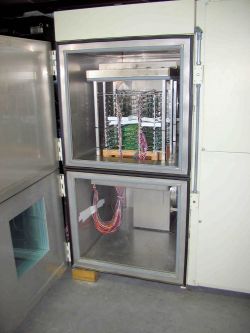Our customers often ask, What is the Difference Between Thermal Shock and Temperature Cycle Testing? Both types of tests expose products to cycles between hot and cold temperatures. Both tests produce stresses caused by thermal expansion and contraction. In many cases, components expand and contract differently. This creates cumulative fatigue damage during each cyclic, which could result in a fatigue failure.
Thermal shock exposes devices to rapid temperature changes greater than 15°C/minute. Temperature cycle testing uses a transition rate less than 15°C/minute and is usually between 1 to 10°C/minute from our experience.
Examples of sources where thermal shock may occur are:
- Rapid changes in environment such as transfer of items between a temperature controlled environment to an outdoor extreme temperature
- Sudden change when starting equipment that was stored outside in an artic climate
- Sudden large internal power changes
- Ascent from a high temperature ground environment to high altitude
Examples of sources where slower thermal cycles may occur are:
- Powering electronics on and off in a controlled environment
- Slower daily outdoor temperature changes between night and day
The soak times at each hot and cold temperature vary greatly for different items. The soak times are mainly dependent on the thermal masses of the larger components within each product. Soak time can typically vary from 15 minutes to 2 hours. Soak times are also dependent on whether the units are powered or unpowered during testing.
Thermal shock failures could be different from temperature cycle failures. Failures from thermal shock could be more of an overstress type. Thermal shock failures on solder joints tend to be caused by tensile overstresses and tensile fatigue. Thermal cycle failures on solder joints components are typically from shear creep fatigue and stress relaxation.
Thermal shock testing is typically performed in a dual compartment chamber. One compartment is for hot temperature and the other is for cold temperature. Products are placed in a carriage that shuttles between the hot and cold compartments within seconds exposing the test item to thermal shock. For large specimens, a single compartment chamber can be used that can perform rapid temperature changes. DES has both types of chambers.
Temperature cycle testing is performed in a single compartment chamber, either a chamber that controls only temperature or a temperature humidity chamber. Most temperature humidity chambers can perform thermal cycling with or without adding controlled humidity. DES conducts temperature cycle testing using both types of single compartment chambers.
Typical test specifications include:
- MIL-STD-202, Method 107, Thermal Shock
- MIL-STD-810, Method 503, Temperature Shock
- MIL-STD-883, Method 1010, Temperature Cycling
- JESD22-A104, Temperature Cycling
- JESD22-A105, Power & Temperature Cycling
- IEC 60068-2-14, Change of Temperature
- RTCA/DO-160, Section 5.0 – Temperature Variation
Delserro Engineering Solutions, Inc. (DES) has many years of experience performing thermal shock and temperature cycle testing. We can assist you with setting up a test, choosing the proper test conditions or choosing a test specification. Please contact us or call 610.253.6637 to find out what DES can do for you!
